#lora mesh network
Text
GPIOs do LoRaMesh da Radioenge: Portas digitais
Aprenda como usar as GPIOs do módulo LoRaMesh da Radioenge
As GPIOs do LoRaMesh da Radioenge possibilita que possamos fazer aplicações de automação com um uso reduzido de hardware, dedicando apenas ao circuito de chaveamento (se necessário) e de alimentação.
No total temos no LoRaMesh 8 GPIOs sendo todas configuráveis como entrada ou saída digital e duas como leitura analógica. Porém neste post vamos apenas abordar as portas digitais.
Por qual motivo…
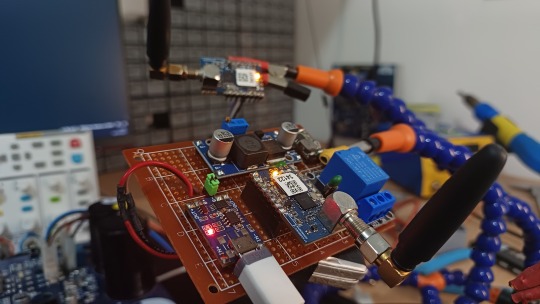
View On WordPress
#lora mesh arduino#lora mesh chat#lora mesh device#lora mesh library#lora mesh module#lora mesh network#lora mesh network raspberry pi#lora mesh protocol#lora mesh radio#lora mesh range#lora vs lorawan#loramesh#lorawan#lorawan devices#lorawan gateway#lorawan network#mesh lora
0 notes
Text
Tag game! Thanks @thebloker for tagging me it makes me feel included XD
Tag 10 people to know better: @maplepastry @janeandthehivequeen @nightapproaches all I got I don't really talk to people on here
Relationship status: engaged to an incredible person named Artemis
Fav color: blue, like a really nice deep blue
Fave food:uhhhhhh, fuckin, uhhh, scalloped potatoes and ham. It's like, cubed ham, and scalloped potatoes, and a really nice creme sauce, all covered with cheese and then broiled so it'll nice and browned. Please look it up it's so good
Song stuck in head: I'd have to say I've had "Leave her Jonny" stuck in my head for about 3 years? It always comes through when I want to hum something to the point where it's almost annoying. But I still love it.
Last thing googled: diy meshtastic LoRa board. It's a really cool open source mesh network for sending encrypted messages off grid, you all should look into it it's great cause you don't need cell towers or anything.
Dream trip: never really thought about it cause it's been outta the price range. Id say down to Oklahoma to visit my friends. We helped them move down there and it's been a year and a half since we've seen them.
Last book read: oh God, it's been years since I've read fiction. Most recent book I've like, opened and read is millwrights and mechanics guide 5th edition. Very interesting stuff tbh but uh, kinda old.
Last book enjoyed:see above, it is a very good book XD
Last book hated: N/A if I didn't like a book I didn't read it so I don't remember any XD yes this applied to school, SparkNotes saved my life
Fave thing to do: usually video games. Picked up escape from tarkov 12 days ago and it's so much better than I expected. Other than that I build electronics, trying to fix a motorcycle, I wanna try making body armor from milk jugs (not crazy I promise), work at my forge, the standard adhd rotation ya know.
Most niche dislike: damn, I'm trying really hard and can't think of one. Id say like, missing one tool from a set but I feel that's pretty common. I got nothing sorry XD
Ok but this was really fun so thanks again to @thebloker for tagging me and making me feel included 🥰
2 notes
·
View notes
Text
[Media] Disaster-Radio LoRa32
Disaster-Radio LoRa32
Disaster-radio is an off-grid, solar-powered, long-range mesh network built on free, open source software and affordable hardware. Designed to be open, distributed, and decentralized.
With this device you can create your own network to exchange messages! And you don't need anything but this device and sunlight :)
Repository:
https://github.com/sudomesh/disaster-radio
Website:
https://disaster.radio/
Buy online:
🛒 https://ali.ski/jXRsIy
#radio #mesh
YouTubeOFF-GRID LORA Radio Mesh Text Messaging - MeshtasticHere we take a look at MESHTASTIC, An Open Source hiking, pilot, skiing and secure GPS mesh communicator using LORA Purchase here: https://ift.tt/ZFrfczN Or purchase here: https://ift.tt/lxZkMd5 Batteries: https://ift.tt/d4ayuoz https://ift.tt/9ZVMeJL Meshtastic Website https://meshtastic.org Join this channel to get access to perks: https://www.youtube.com/channel/UC9a8Z6Sp6eb2s3O79pX5Zvg/join Products used in my videos can be purchased through my Amazon storefront. US ► https://ift.tt/FRJBkmQ UK ► https://ift.tt/cTXF6Pw Support This Channel by becoming a Patreon. My Patreon ► https://ift.tt/3JBRDMa My Twitter ► https://twitter.com/techmindsyt My Amazon ► https://ift.tt/thVoPBX My PayPal ► https://ift.tt/Cw0ndx1 Merch Store ► https://ift.tt/neboF0M If you enjoyed this video please help me out by subscribing and help me get to my next Milestone of 50,000 Subscribers! #TechMinds #LORA #HamRadio
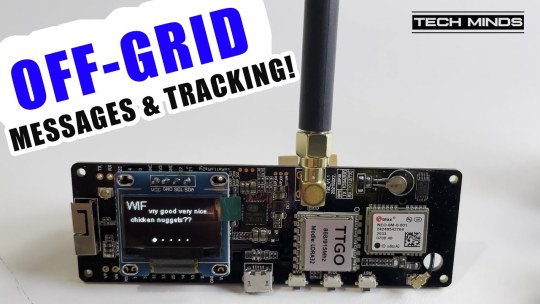
2 notes
·
View notes
Text
Meshtastic Mesh Coverage
With a mesh network, the range between nodes in a network can be significantly extended.
Due to the limited bandwidth of LoRa, Meshtastic does not track the forwarding of a message to its destination. The traceroute module can provide information on this.
Only nodes that know the encryption of the channel used can be tracked. A message can arrive via several routes due to re-broadcasting. The…

View On WordPress
0 notes
Text
Ook in Nederland is Meshtastic® een actief project waarmee je met LoRa-apparaten gebruik kunt maken van een off-grid communicatie netwerk over lange afstand. Meshtastic is community-gedreven en open source en kan worden gebruikt tijdens rampen of noodsituaties. Het platform is specifiek ontworpen om robuuste communicatie mogelijk te maken in situaties waar traditionele communicatie-infrastructuur mogelijk is uitgevallen of niet beschikbaar is.
Een groot aantal node eigenaren en gebruikers zijn te vinden in de Meshtastic Netherlands Telegram groep en op Facebook.
Enkele voordelen van Meshtastic;
Onafhankelijke communicatie: Meshtastic werkt zonder telefoon- en internetverbinding. Dit betekent dat het kan worden ingezet in gebieden waar communicatie-infrastructuur beschadigd is of niet meer functioneert.
Mesh-netwerkfunctionaliteit: Meshtastic kan automatisch een mesh-netwerk opzetten waarbij nodes onderling verbinding maken en routes vinden om gegevens door te sturen.
Privacy en veiligheid: Meshtastic maakt gebruik van gegevensencryptie om de privacy en beveiliging van communicatie te waarborgen, waardoor gebruikers berichten veilig kunnen uitwisselen.
Open source: Als open-sourceplatform profiteert Meshtastic van een actieve gemeenschap van gebruikers en ontwikkelaars die voortdurend nieuwe functies toevoegen en verbeteringen aanbrengen.
Eenvoudig: Omdat Meshtastic een open-sourceplatform is en gebruikmaakt van relatief eenvoudige hardware, kan het snel worden geïmplementeerd in noodsituaties, zonder dat er complexe infrastructuur nodig is.
Energiezuinig: Het platform is ontworpen met een focus op energiezuinigheid, waardoor het geschikt is voor gebruik op batterijgevoede apparaten zoals draagbare nodes.
Goedkoop: Buiten de eenmalige aanschafkosten van een geschikte LoRa-apparaat zijn er geen bijkomende kosten. Op deze manier kunt u al voor enkele tientjes klaar zijn.
Meshtastic kan in verschillende situaties handig zijn, zoals:
Buitensportactiviteiten: Tijdens trektochten, kamperen, wandelen, fietsen en andere buitensportactiviteiten waar traditionele communicatiemiddelen zoals mobiele netwerken niet of nauwelijks beschikbaar zijn.
Noodsituaties en rampen: In noodsituaties zoals natuurrampen, stroomuitval of andere noodsituaties waarbij traditionele communicatiemiddelen kunnen uitvallen, kan Meshtastic een betrouwbare communicatieoplossing bieden.
Outdoor-evenementen en festivals: Bij grote outdoor-evenementen zoals festivals, concerten of sportevenementen waar traditionele mobiele netwerken overbelast kunnen raken, kan Meshtastic worden gebruikt om communicatie te behouden tussen medewerkers, beveiligingspersoneel en deelnemers.
Community-netwerken: In gemeenschappen waar geen toegang is tot traditionele communicatie-infrastructuur, kunnen lokale Meshtastic-netwerken worden opgezet om onderlinge communicatie en samenwerking te vergemakkelijken.
Kortom, Meshtastic kan in verschillende situaties handig zijn waar betrouwbare communicatie over lange afstanden nodig is zonder afhankelijk te zijn van traditionele mobiele netwerken.
#meshtastic#communicatie#communication#netherlands#nederland#meshtastic nederland#meshtastic netherlands#dutch#mesh
0 notes
Text
The features of the 160W high-power long-range data transmission station
The LoRa611II-DZ long-range data transmission station offers multiple transmission modes,NO MESH,MESH, with selectable operating frequencies of 433/470/868/915 MHz. It provides TTL/RS232/RS485 interfaces. Utilizing LoRa spread spectrum modulation with frequency hopping technology, it achieves high reception sensitivity, surpassing the penetration capability and communication range of commonly used FSK and GFSK products, while also exhibiting stronger anti-interference properties.
AES128 Data Encryption Mode
The LoRa611II-DZ data transmission module features built-in data encryption functionality, and additionally supports AES128 encryption. Users can freely read or modify the module's AES128 key through PC software. Enabling AES128 encryption mode may slightly increase the wireless transmission delay, but provides the best protection for airborne data. Customers with high requirements for data transmission encryption can enable the module's AES128 encryption functionality.
LBT Function (Listen Before Talk)
When multiple transmitters are operating simultaneously, the data transmission module ensures that they do not interfere with each other and avoid conflicts. Before transmitting, the module checks whether other transmitters are currently emitting wireless signals in the environment. If other transmitters are detected, the module temporarily refrains from transmitting until those transmitters stop emitting signals.
CRC Check
The module has activated the CRC check within the wireless chip, providing an internal verification mechanism for wireless data. However, in extreme conditions, it has been observed that interfered wireless data may bypass the CRC check, leading to the module outputting erroneous data. CRC checks are typically employed in data communication, particularly in digital and network communication, to ensure data integrity and accuracy.
No Blind Spots, No Distance Limitations: Single Module Clear Transmission up to 5km @ Low Speed
Under low-speed conditions, this module disregards blind spot restrictions, enabling comprehensive communication coverage in all directions and positions without any blind spots or limitations on communication distance. In an ideal open environment, communication between individual modules can extend up to 5 kilometers.

Optional Hop Count in MESH Mode
In MESH (Mesh Networking) mode, the optional hop count refers to the maximum number of hops that data can traverse between each node in the network. The hop count determines the number of intermediate nodes data passes through from the source node to the destination node.
The configurable hop count allows users to adjust the network's transmission distance and latency based on specific application requirements and network topology. By increasing or decreasing the hop count, the coverage range and transmission performance of the network can be adjusted to meet various communication demands.
Typically, increasing the hop count will increase data transmission latency but can expand the network's coverage range. Conversely, reducing the hop count will decrease latency but may limit the network's coverage range. Therefore, users can flexibly adjust the hop count settings according to their specific application scenarios and requirements to achieve optimal communication performance.
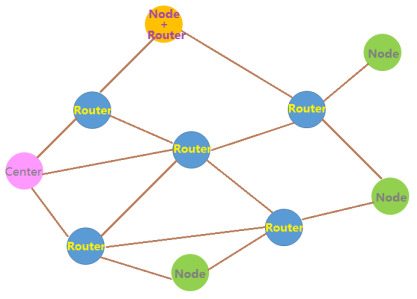
Node/Router/Node+Router Optional in MESH Mode
In MESH mode, the option of Node/Router/Node+Router refers to the ability to configure devices as nodes, routers, or both nodes and routers when building a Mesh network.
Node (Node): In a Mesh network, a node refers to a device that does not have the capability to forward data but can only transmit and receive data as an end device. Nodes are typically used to connect terminal devices such as sensors, terminal controllers, etc., to send data to other devices in the network or receive data from other devices.
Router (Router): In a Mesh network, a router refers to a device with the capability to forward data. It can receive data from other devices and forward it to the target device. Routers can build routing tables in the network and transmit data packets to the correct destination device based on the packet's destination address. Routers are typically used to build the backbone structure of the network and are responsible for data forwarding and relaying.
Node+Router: Some devices have the ability to function as both nodes and routers simultaneously. This means they can participate in data transmission as end devices and also forward data as routers to other devices. Such devices can enhance the stability and coverage range of the Mesh network, making the network more resilient and fault-tolerant.n
Note:
lIn the same MESH network, all modules including nodes, routers, and node + routers need to have different NODE IDs set.
lWhen hop=0, the number of hops is not limited. When Hop=n, the data packet can be forwarded a maximum of n times. When HOP>0, the number of hops set in modules within the same MESH network can be different.
lModules with hop=0 cannot communicate with modules where hop>0.
lTo communicate with older versions that do not have the hop count feature, set hop to 0.

Built-in hardware reset protection circuit
The built-in hardware reset protection circuit refers to a circuit integrated within the device, designed to safeguard the device from adverse effects caused by unexpected power fluctuations or interference. This circuit enhances the stability and reliability of the device, shielding it from external environmental factors, thereby extending its lifespan and enhancing both its safety and performance.
40 communication channels in the same frequency band
The number of communication channels in the same frequency band typically refers to the non-overlapping frequency channels that devices can use. This feature is crucial for avoiding channel interference and enhancing communication efficiency. Therefore, devices with 40 communication channels offer better communication performance and flexibility, enabling them to better meet complex communication requirements.
The data transmission station demonstrates versatile applications across various fields, catering to diverse scenarios:
Wireless Remote Control: The data transmission station enables wireless control of various devices, machines, or systems, such as remote-controlling vehicles, robots, or model aircraft.
Remote Meter Reading: In utility sectors like water, electricity, or gas, the data transmission station facilitates remote meter reading, allowing for remote monitoring and management of user consumption.
Industrial Data Acquisition: In industrial settings, the data transmission station can collect data from various sensors and equipment status information, facilitating the monitoring of production processes and equipment operation.
Home Automation Telemetry: Within smart home systems, the data transmission station can be utilized for home automation telemetry, including remote monitoring of environmental parameters such as temperature, humidity, and light levels.
Wireless Data Communication: Serving as a wireless communication device, the data transmission station supports various data communication scenarios, including remote control, text,ect.
Access Control Systems: The data transmission station can be applied to access control systems, achieving remote control and monitoring of access devices, including access control switches and records
The technical features and diverse application scenarios of the LoRa611II-DZ data transmission station make it a standout in the field of wireless communication. Whether it's long-distance transmission, data encryption, interference resistance, flexible network configuration, or multi-frequency band selection, it demonstrates stability and reliability in various complex environments. Whether you're seeking limitless remote control, secure remote monitoring, industrial data acquisition, or smart home applications, the LoRa611II-DZ data transmission station can meet your needs, providing robust support and assurance for your applications.
For details, please click:https://www.nicerf.com/products/
Or click:https://nicerf.en.alibaba.com/productlist.html?spm=a2700.shop_index.88.4.1fec2b006JKUsd
For consultation, please contact NiceRF (Email: [email protected]).
For details, please click:https://www.nicerf.com/products/
Or click:https://nicerf.en.alibaba.com/productlist.html?spm=a2700.shop_index.88.4.1fec2b006JKUsd
For consultation, please contact NiceRF (Email: [email protected]).
0 notes
Text
What is the difference between the LoRaWAN wireless module and LoRa gateway wireless transmission technology?
Many individuals find it challenging to differentiate between the LoRaWAN wireless module and LoRa gateway wireless transmission technology, as well as their applications within the realm of IoT.

LoRaWAN specifically pertains to the networking protocol found within the MAC (Media Access Control) layer. In contrast, LoRa serves as a protocol within the physical layer. Although current LoRaWAN networking implementations utilize LoRa as the physical layer, it's worth noting that the LoRaWAN protocol also allows for the use of GFSK (Gaussian Frequency-Shift Keying) as the physical layer in specific frequency bands. From a network layering perspective, LoRaWAN can adopt various physical layer protocols, just as LoRa can serve as the physical layer for other networking technologies.
LoRa, as a technology, falls under the category of LPWAN (Low-Power Wide-Area Network) communication technologies. It represents an ultra-long-distance wireless transmission method based on spread spectrum technology, pioneered and promoted by Semtech in the United States. This approach revolutionizes the previous trade-off between transmission distance and power consumption, offering users a straightforward system capable of achieving extended range, prolonged battery life, and increased capacity. Consequently, it expands the capabilities of sensor networks. Currently, LoRa predominantly operates within free frequency bands globally, including 433/868/915MHz, among others.
On the other hand, LoRaWAN wireless communication stands as an open standard defining the communication protocol for LPWAN technology based on LoRa chips. LoRaWAN defines the Media Access Control (MAC) layer at the data link level and is overseen by the LoRa Alliance. It's crucial to distinguish between LoRa and LoRaWAN because companies like Link Labs utilize a proprietary MAC layer in conjunction with LoRa chips to create more advanced hybrid designs, such as Link Labs' Symphony Link.
LoRaWAN typically employs a star or star-to-star topology, which is generally considered superior to mesh networks due to advantages such as conserving battery power and extending communication range. In a star topology, messages are relayed to a central server through gateways, and each end node can transmit data to multiple gateways. These gateways then forward the data to the web server, where tasks like redundancy detection, security checks, and message scheduling are executed.
In summary, LoRa encompasses solely the link layer protocol, making it suitable for point-to-point (P2P) communication between nodes. In contrast, LoRaWAN includes the network layer, allowing data to be sent to any base station connected to a cloud platform. By connecting the appropriate antenna to its socket, the LoRaWAN module can operate at different frequencies, offering versatility in its applications.
0 notes
Text
Top IoT powered building automation protocols you must be aware of
https://www.zenatix.com/top-iot-powered-building-automation-protocols-you-must-be-aware-of/

At present, there are more than 12.2 billion active global IoT connections. These interconnected devices communicate with each other and produce meaningful data. However, only communication is not enough. They need to speak the same language. It’s the point where IoT protocols come to use!
What are IoT protocols?
A protocol is a set of rules that allows for the effective communication (i.e., data exchange) of distinct machines/devices in a network setting. The protocols also apply to the Internet of Things (IoT).
Why do IoT Protocols matter?
IoT protocols give smart systems the ability to communicate with each other seamlessly. Moving data from endpoint devices through the IoT pipeline to central servers becomes a matter of a few minutes with IoT protocols.
It is only IoT protocols that make sure data sent from endpoint devices, such as sensors, is received and understood by the subsequent steps in the connected environment. They are as critical to the existence of IoT as the things themselves.
Though protocols work collectively to make IoT work, not all of them are created equal. Some IoT protocols work well in buildings, while some are well suited for IoT deployments spread among buildings.
Some popular IoT Protocols
Several IoT protocols enable either device-to-device, device-to-gateway, or device-to-cloud/data center communication — or combinations of these communications. Here are some of the most common and popular IoT protocols:
BACnet
BACnet is a communication IoT protocol for building automation and control (BAC) networks. It’s designed to enable communication of building automation and control systems for applications including heating, ventilating, and air-conditioning control (HVAC automation systems), lighting control, access control, fire detection systems, and other building equipment.
BACnet provides mechanisms for computerized building automation devices to exchange information, regardless of the particular building service they perform. It’s mainly used in building automation systems (BAS) to control the data exchange between different devices and components.
The top features of BACnet include:
Open source standard
No license fee for implementation
Adopted by a large number of manufacturers, making them less dependent on a specific vendor for their implementation
BACnet fulfills all the merits of a standardized protocol.
Modbus
Modbus protocol is used for transmitting information over serial lines between electronic devices. This open protocol is widely used by many manufacturers throughout many industries. It transmits signals from instrumentation and control devices back to the main controller or data-gathering system.
Since it’s openly published and royalty-free, this IoT protocol is popular in industrial environments. It is relatively easy to deploy and maintain as compared to other standards. In the field of process automation and SCADA (Supervisory Control and Data Acquisition), Modbus is the most popular and oldest automation protocol.
OpenThread
Released by Google, OpenThread is an open-source implementation of Thread. It comes with specifications that define an IPv6-based reliable, secure, and low-power wireless device-to-device communication protocol for home and commercial building applications.
Top features:
IPv6 configuration and raw data interface
Extending Thread mesh over Ethernet/Wi-Fi links
Bidirectional IPv6 reachability and DNS-based service discovery between Thread and Ethernet/Wi-Fi
UDP sockets
CoAP client and server
DHCPv6 client and server
DNSv6 client
Child Supervision
Inform Previous Parent on Reattach
Jam Detection
Periodic Parent Search
This IoT protocol is highly portable that supports both System-on-Chip (SoC) and Co-Processor (RCP, NCP) designs.
LoRaWan
LoRaWAN is a Low Power Wide Area Networking (LPWAN) communication protocol that functions on LoRa. Anyone can set up and operate the LoRa network.
It’s designed to wirelessly connect battery-operated ‘things’ to the internet in regional, national or global networks, and targets key Internet of Things (IoT) requirements such as bi-directional communication, end-to-end security, mobility, and localization services.
Top features:
Long-range communication up to 10 miles in line of sight
Low cost for devices and maintenance
License-free radio spectrum but region-specific regulations apply
Low power but has a limited payload size of 51 bytes to 241 bytes as per the data rate, which can be 0,3 Kbit/s – 27 Kbit/s data rate with a 222 maximal payload size.
The rise of IoT is giving rise to radical changes in how devices communicate with each other. IoT protocols will help increase in adoption and importance as the number of connected devices rises.
Being the leading IoT powered building automation provider in India, Zenatix offers an IoT-powered energy monitoring & asset management solution (ZenConnect) delivering energy efficiency, improved comfort compliances, & reduced asset breakdown for commercial buildings
View Source : https://www.zenatix.com/top-iot-powered-building-automation-protocols-you-must-be-aware-of/
0 notes
Text
Smart BAN
Introduction to Smart Body Area Networks
Body area networks, or BANs, provide benefits over broader range wireless solutions, such as 5G and LoRa. A BAN is a wireless network of sensors, actuators, and other devices installed around the human body for interpersonal or environmental interaction. Smart BANs are made up of wearable sensors communicating over a low-power mesh network to connect…

View On WordPress
0 notes
Text
Leitura analógica do LoRaMesh da Radioenge
Aprenda como usar a leitura analógica com o módulo LoRaMesh da Radioenge
A leitura analógica com o LoRaMesh possibilita com que possamos fazer um amplo sistema de sensoriamento remoto sem precisar necessariamente de microcontrolador adicional na parte do slave.
Por qual motivo usar a leitura analógica do LoRaMesh da Radioenge?
Uma leitura digital em muito dos casos já é mais que o suficiente para saber se algo está ou não funcionando, mas a leitura analógica do…

View On WordPress
#lora mesh arduino#lora mesh chat#lora mesh device#lora mesh library#lora mesh module#lora mesh network#lora mesh network raspberry pi#lora mesh protocol#lora mesh radio#lora mesh range#lora vs lorawan#loramesh#lorawan#lorawan devices#lorawan gateway#lorawan network#mesh lora
0 notes
Link
When the critical infrastructure that so many of us take for granted goes away, how do we organize ourselves and our communities to respond?
If recent ecological disasters have demonstrated anything, it is the inadequacy of existing models and tools to provide efficient allocation of resources, access to emergency communications, and effective coordination of human effort. Few if any solutions exist that are off-grid, affordable, reliable, easily deployed, and openly standardized.
...
disaster.radio is an off-grid, solar-powered, long-range mesh network built on free, open source software and affordable, open hardware.
Designed to be open, distributed, and decentralized, disaster.radio is currently in the prototype/development phase. To learn more about the technologies driving our development, visit the following pages:
Firmware
Hardware
Software
User guides
disaster.radio is a collaborative project between Sudo Mesh and Secure Scuttlebutt, with additional support from the Internet Society and Institute For the Future.
Read more: https://disaster.radio/
#arduino #lora #lorawan #radio #ham #offgrid #solar #mesh #network
youtube
5 notes
·
View notes
Text
What is the IoT? Everything you need to know about the Internet of Things right now
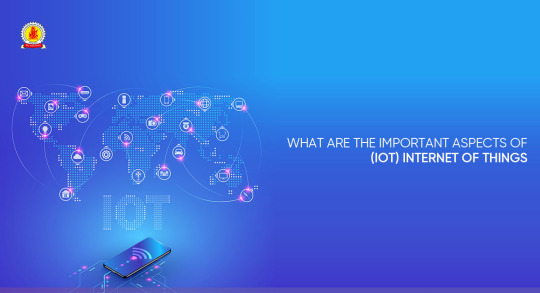
The essence of IoT is networking that student of Top Information Technology College should be followed. In other words, technologies will use in IoT with a set protocol that they will use for communications. In Communication, a protocol is basically a set of rules and guidelines for transferring data. Rules are defined for every step and process during communication between two or more computers. Networks must follow certain rules to successfully transmit data.
While working on a project, there are some requirements that must be completed like speed, range, utility, power, discoverability, etc. and a protocol can easily help them find a way to understand and solve the problem. Some of them includes the following:
1. The List
There are some most popular IoT protocols that the engineers of top engineering colleges in Jaipur should know. These are primarily wireless network protocols.
2. Bluetooth
Bluetooth is a wireless technology standard for exchanging data over some short distances ranges from fixed and mobile devices, and building personal area networks (PANs). It is invented by Dutch electrical engineer, that is, Jaap Haartsen who is working for telecom vendor Ericsson in 1994. It was originally developed as a wireless alternative to RS-232 data cables.
3. ZigBee
ZigBee is an IEEE 802.15.4-based specification for a suite of high-level communication protocols that are used by the students of Best Engineering Colleges Jaipur to create personal area networks. It includes small, low-power digital radios like medical device data collection, home automation, and other low-power low-bandwidth needs, designed for small scale projects which need wireless connection. Hence, ZigBee is a low data rate, low-power, and close proximity wireless ad hoc network.
4. Z-wave
Z-Wave is a wireless communications protocol used by the students of BTech information technology college in Jaipur primarily for home automation. It is a mesh network using low-energy radio waves to communicate from appliance to appliance which allows wireless control of residential appliances and other devices like lighting control, thermostats, security systems, windows, locks, swimming pools and garage door openers.
5. Thread
A very new IP-based IPv6 networking protocol aims at the home automation environment is Thread. It is based on 6LowPAN and also like it; it is not an IoT applications protocol like Bluetooth or ZigBee. However, it is primarily designed as a complement to Wi-Fi and recognizes that Wi-Fi is good for many consumer devices with limitations for use in a home automation setup.
6. Wi-Fi
Wi-Fi is a technology for wireless local area networking with devices according to the IEEE 802.11 standards. Wi-Fi is a trademark of the Wi-Fi Alliance which prohibits the use of the term Wi-Fi Certified to products that can successfully complete interoperability certification testing.
Devices that can use Wi-Fi technology mainly include personal computers, digital cameras, video-game consoles, smartphones and tablets, smart TVs, digital audio players and modern printers. Wi-Fi compatible devices can connect to the Internet through WLAN and a wireless access point. Such an access point has a range of about 20 meters indoors with a greater range outdoors. Hotspot coverage can be as small as a single room with walls that restricts radio waves, or as large as many square kilometers that is achieved by using multiple overlapping access points.
7. LoRaWAN
LoRaWAN is a media access control protocol mainly used for wide area networks. It is designed to enable students of private engineering colleges in Rajasthan to communicate through low-powered devices with Internet-connected applications over long-range wireless connections. LoRaWAN can be mapped to the second and third layer of the OSI model. It is implemented on top of LoRa or FSK modulation in industrial, scientific and medical (ISM) radio bands.
8. NFC
Near-field communication is a set of communication protocols that enable students of best engineering colleges in Rajasthan two electronic devices. One of them is usually a portable device like a smartphone, to establish communication by bringing them within 4cm (1.6 in) of each other.
These devices are used in contactless payment systems like to those used in credit cards and electronic ticket smartcards and enable mobile payment to replace/supplement these systems. Sometimes, this is referred to as NFC/CTLS (Contactless) or CTLS NFC. NFC is used for social networking, for sharing contacts, videos, photos, or files. NFC-enabled devices can act as electronic identity both documents and keycards. NFC offers a low-speed connection with simple setup that can be used by the students of top Engg colleges in Rajasthan to bootstrap more capable wireless connections.
9. Cellular
IoT application that requires operation over longer distances can take benefits of GSM/3G/4G cellular communication capabilities. While cellular is clearly capable of sending high quantities of data, especially for 4G with the expense and also power consumption will be too high for many applications. Also, it can ideal for sensor-based low-bandwidth-data projects that will send very low amounts of data over the Internet. A key product in this area is the SparqEE range of products including the original tiny CELLv1.0 low-cost development board and a series of shield connecting boards for use with the Raspberry Pi and Arduino platforms.
10. Sigfox
This unique approach in the world of wireless connectivity; where there is no signaling overhead, a compact and optimized protocol; and where objects are not attached to the network. Sigfox offers a software-based communications solution to the students of top engineering colleges in India where all the network and computing complexity is managed in the Cloud, rather than on the devices. All that together, it drastically reduces energy consumption and costs of connected devices.
SigFox wireless technology is based on LTN (Low Throughput Network). It is wide area network-based technology which supports low data rate communication over larger distances. It is mainly used for M2M and IoT applications which transmits only few bytes per day.
0 notes
Text
Know some facts about Smart Home Automation
ME Universal idea of clever constructing is any shape that makes use of computerized procedure to mechanically manipulate the homes operations together with heating, ventilation, air conditioning, lighting , safety and different systems. Our constructing idea makes use of sensors and different wireless / stressed gadgets to gather facts and control it in line with the features of the constructing and services. ME Universal works with IP500, Endogean, Lora, ZigBee, Bluetooth and different IOT Standards which can be into Wireless Mesh Networking to speak among exclusive equipment's in the constructing for this reason growing a clever constructing/township that is steady and complete of facts for operational and protection decisions. The complete concept of IOT Buildings is to store money/fee in the course of or after the constructing is occupied for this reason financial savings for the investor, assets proprietor and tenant. Our Product primarily based totally IOT Solutions are designed for the subsequent technology homes that is centered at the Smart Home Automation Cleaning, Waste Management, Lighting and so forth to peer that the constructing equipment's also are IOT ready
0 notes
Text
Advancing Fire Intercom Communication: Innovative Applications of Full Duplex Concurrent Reception and Transmission Intercom Modules
LoRa wireless technology, short for Long Range Radio, is a specialized technology designed for long-distance wireless communication. Its core advantage lies in its ability to achieve extended transmission distances under low power conditions, thus achieving a perfect balance between low power consumption and long-distance transmission! Among the numerous products utilizing LoRa technology, the LoRa digital voice module developed by NiceRF has made significant achievements in the development of high-end full-duplex intercoms.
The SA618F30, produced by NiceRF, is a high-performance, cost-effective, and highly integrated high-power full-duplex wireless audio module. It features a high-speed microcontroller, high-performance RF transceiver chip, and RF power amplifier built-in. It also provides a standard serial port for communication with the module, allowing for easy and quick setup of module parameters and control of transmission and reception functions. Users only need to connect audio amplifiers, microphones, and speakers to this module, and it can function as a small-scale intercom device.

Highlighting the Application of Full-Duplex Concurrent Reception and Transmission Intercom Modules in Fire Communication
Full-Duplex Intercom is well-known for allowing both communication parties to simultaneously send and receive data, enabling two-way communication, much like having a conversation where you can talk and hear the other person's response at the same time. Concurrent reception and transmission in intercom modules refer to the capability of wireless communication modules to simultaneously handle multiple connections and conduct data transmission and reception. This capability is crucial in modern communication systems as it can enhance communication efficiency, increase network capacity, and support simultaneous connections of multiple users and devices.
The SA618F30 full-duplex digital intercom module supports up to 8 devices simultaneous transmission (unlimited reception), with features including echo cancellation and multi-level wireless relay (MESH networking). It can be used for various specialized operations intercom, such as fire communication.

The fire intercom system plays a crucial role in emergency situations, as it needs to provide reliable two-way communication for firefighters to coordinate actions and convey critical information promptly. The use of full-duplex simultaneous transmission and reception technology can further enhance the efficiency and practicality of the fire intercom system.
The application of full-duplex simultaneous transmission and reception modules in fire systems can be comprehensively explained from the following points:
Real-time bidirectional communication: Full-duplex communication enables firefighters to issue instructions while simultaneously receiving real-time feedback, ensuring bidirectional flow of information. Efficiency improvement: In emergency situations, prompt delivery of instructions and feedback enhances the responsiveness of rescue operations.
Simultaneous transmission and reception function: Multi-tasking capability: Supporting firefighters to send messages while receiving critical information from other teams or command centers. Strengthening emergency response: This capability is crucial at fire scenes, aiding in coordinating actions among all parties and effectively responding to emergencies.
Multi-channel multiplexing and bandwidth saving: Efficient transmission: Simultaneous transmission to multiple recipients is made possible by the simultaneous transmission and reception technology, such as broadcasting emergency situations or emergency instructions. Resource optimization: This technology reduces the demand for bandwidth and system resources, enhancing the efficiency and reliability of information transmission.

Echo cancellation and wireless relay: Clear communication: Echo cancellation functionality ensures communication clarity in noisy environments. Network expansion: Multi-level wireless relay (MESH networking) functionality expands communication coverage, ensuring smooth communication in complex environments.
Enhanced communication reliability and security: Redundancy mechanism: Simultaneous transmission and reception technology support multiple devices transmitting simultaneously, enhancing communication redundancy and system reliability. Encryption technology: Combined with encryption technology, it ensures the security of communication content, preventing information leakage or malicious interference.
The application of full-duplex simultaneous transmission and reception technology in fire communication systems significantly enhances communication efficiency, reliability, and security, providing robust technical support for fire emergency response.
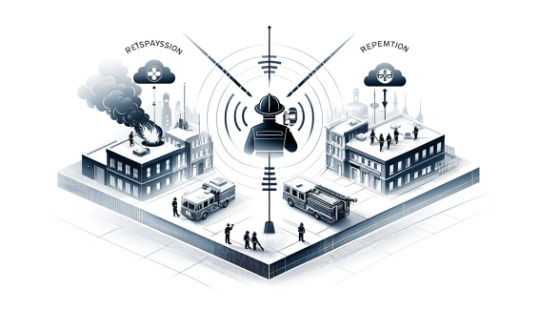
Additionally, by utilizing the simultaneous transmission and reception technology, fire intercom systems can simultaneously broadcast critical information to multiple recipients, such as emergency situations or instructions to different firefighting teams, without the need to send messages separately to each recipient. This multi-channel multiplexing approach not only saves bandwidth and system resources but also enhances the efficiency and reliability of information transmission.
In conclusion, full-duplex simultaneous transmission and reception technology enhances the efficiency and reliability of fire communication. Firefighters can transmit information in real-time while receiving feedback from other teams promptly, supporting rapid information exchange and decision-making, effectively responding to emergencies. Applying full-duplex simultaneous transmission and reception technology in fire intercom systems ensures timely and effective delivery of critical information and instructions, thereby enhancing the efficiency and safety of firefighting emergency response.
For details, please click:https://www.nicerf.com/products/
Or click:https://nicerf.en.alibaba.com/productlist.html?spm=a2700.shop_index.88.4.1fec2b006JKUsd
For consultation, please contact NiceRF (Email: [email protected]).
0 notes
Text
Choosing the Best IoT Data Connectivity for IoT Platform

IoT data connectivity is the most fundamental requirement of an IoT use case. However, not every IoT platformutilizes the same connectivity solutions. In order to maximize the benefit from an IoT business, one needs to have the most appropriate connectivity solution.
Selecting the Best Wireless Technology for IoT
IoT is a diverse technology. There are many IoT sensors that remain connected and transmit signals to ensure proper implementation of an IoT network. For someone trying to leverage IoT for best gains, it is important to have information about every type of IoT connectivity available.
Have a look at some IoT connectivity types and their best use scenarios:
Mobile Network Connectivity
3G, 4G and 5G are the most basic cellular network connectivity types available. When you have to cover large areas, mobile connectivity becomes a necessity. For example, connected cars can move around and still communicate if they are powered by mobile connectivity. In the future, it is expected that 5G-connectivity would power a vast network of self-driving cars. Mobile connectivity is also widely used for long-range IoT surveillance systems.
Low Powered Long Range Connectivity
When you want your IoT devices to be operational for a long time on a single battery charge, Low Powered Long Range Connectivity solutions like SigFox, LoRA, LTE-M and NB-IoT become the ideal choice. These connectivity types maintain a low data rate, which does not exert the sensors. Hence, a single battery charge lasts for a long time and the battery life is also extended. Important use cases for this type of connectivity are monitoring of environment, tracking of assets and monitoring of perishable items.
Mesh Protocols
When there is a need to supply connectivity to several sensors connected in a mesh topology, connectivity solutions like Zigbee are preferred. Although they have a short range of 100 meters or less, they are very effective in reducing the power consumption by sensors.
Wi-Fi Connectivity
When you need to connect a home network that has many IoT devices, Wi-Fi is the most suitable choice. Although it is an expensive connectivity type, it can provide greater bandwidth and low latency. Mostly, it is used for connecting home gadgets and appliances.
When it comes to IoT development, you need the most ideal connectivity solutions for maximum benefit. However, IoT is a vast field and requires greater resources. To fulfill this requirement, it is essential to have an internet of things connectivity provider that can offer versatile connectivity solutions.
Secure IoT Services excels at both connectivity and IoT billing solutions. It also offers superior tech support, so that your network remains operational at all times.
#Internet of things connectivity provider#IoT platform#IoT sensors#iot development#Iot Billing#IoT Data
0 notes